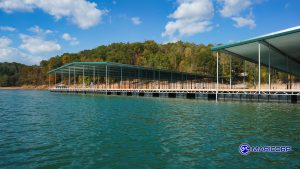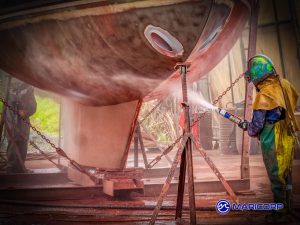Importance of Life Jacket Maintenance and Inspection
Faulty Life Jackets Prompt USCG Safety Alert
In July of 2016, when the U.S. Coast Guard inspected two vessels in Key West, FL, they found more than 60 life jackets that were unsafe for use. Despite being properly stored, kept dry and out of direct sunlight, inspectors found that “the unicellular foam buoyant material within the nylon outer shell had degraded significantly over time, broke apart, crumbled and in some instances was reduced to dust.”
Though attempts had been taken to properly store the life jackets, they failed their life jacket maintenance and inspection. The storage area, while kept dry, was exposed over time to high heat, causing the 9-year old Type 1 life jackets to literally fall apart within the vest. Footnote – the company that produced this life jacket is no longer in business.
The USCG subsequently released a Marine Safety Alert, prompting vessel owners and operators, or any businesses storing or using life jackets, to inspect any Type 1 unicellular personal flotation devices for any signs of failure or degradation.
Defective and Faulty Life Jackets Lead to Drowning
Drowning from faulty or defective life jackets is more common than you think. A quick search on the Internet reveals numerous incidents of drowning due to faulty life jackets.
- Faulty Life Jackets May Be to Blame in Deaths of Three Fishing Boat Crew Members
- Drowning of Adult Male from Failure of Jacket to Inflate
- Faulty Life Jackets to Blame in Three Deaths
Some of those deaths could have been avoided with simple maintenance and inspection of their life jackets.
In the United States, the Coast Guard is responsible for all safety measures on waterways. Routine inspection is just one of many services provided. But that doesn’t mean you can ignore regular maintenance and inspection of your life jackets and personal flotation devices (PFD’s). The worst time to realize that your life jacket doesn’t work is when you need it the most.
Basic Life Jacket Maintenance and Inspection Tips
So what kind of maintenance should you perform? It will mostly depend on the type of life jacket or PFD you own. The manufacturer will have guidelines and directions to service and inspect the life jackets. But some common steps are:
- Only use life jackets and PFD’s approved by the USCG
- Examine all life jackets and PFD’s before each voyage
- Check for signs of wear, holes or tearing, and that seams are securely sewn
- Clean and store your life jacket per manufacturer’s instructions
- Check manufacturer’s website for safety notices or recalls
- Regularly check the USCG website for Safety Alerts
Life Jacket Maintenance and Inspection for Type 1 Unicellular Life Jackets
- Check for compression, which can easily occur from years of storage. Stacking life jackets or placing heavy items on your life jackets in storage can compress the foam, leading to deterioration.
- Examine the resiliency of your life jacket. If it’s excessively hard or stiff, the foam is brittle and can lead to deterioration. An easy test is to squeeze or compress the life jacket to about half its original thickness. If the foam is in good order, it will gradually expand back to the original thickness.
- Look for signs of shrinkage. This is usually indicated by loose or wrinkly fabric that covers the foam. Shrinkage indicates that some of the original buoyancy may have been lost or the overall performance of the life jacket has been compromised or degraded.
Life Jacket Maintenance and Inspection for Inflatable Type Jackets
- If your life jacket has a safety indicator, check the status – make sure it’s green or safe to use.
- Some life jackets have a bright LED or strobe light for night use – make sure it’s in proper working order.
- With auto-inflating life jackets, it’s important to check the arming components and ensure they are not expired. Verify that the batteries are not expired, are in proper contact and show no sign of corrosion or leakage.
- Make sure the CO2 cylinder is properly secured and charged. Check for rust or corrosion. If you remove the cylinder for a visual inspection, be sure to replace it without over-tightening.
- If your life jacket has a manual oral inflation tube, check for obstructions and make sure the tube is not worn or cracked, especially at the connection point. Inflate the life jacket with the oral tube and leave in a room overnight with a constant temperature. If there is no visible loss of pressure, deflate and store per manufacturer’s directions, otherwise replace or have serviced by an approved service center.
Summing it all up…
These are just a few suggestions and you should follow your manufacturer’s instructions – the importance of life jacket maintenance and inspection cannot be overemphasized. And remember too, that all life jackets and PFD’s have a limited shelf life. They need to be replaced as instructed by the manufacturer. The USCG maintains a listing of all Safety Alerts and product recalls on their website.
Additional Safety Articles:
- National Safe Boating Week
- Electric Shock Drowning Prevention Tools
- Choosing a Life Jacket – The First Step to Boating Safety
- 6 Basic Boating Safety Tips and the Stats that Support Them
- Dock Lifeguard Systems ESD Prevention
*Sign up for our free newsletter “Marina Management Journal” so you can stay up to date
Related Maintenance Articles
No links yet.
About MariCorp
Maricorp is one of the largest floating boat dock manufacturing and construction companies in the United States, specializing in galvanized steel floating docks and boat lift systems. With projects spanning coast-to-coast, Maricorp provides marina consultation and design, marine construction, marina repair and renovation, and boat dock disaster response and demolition.














